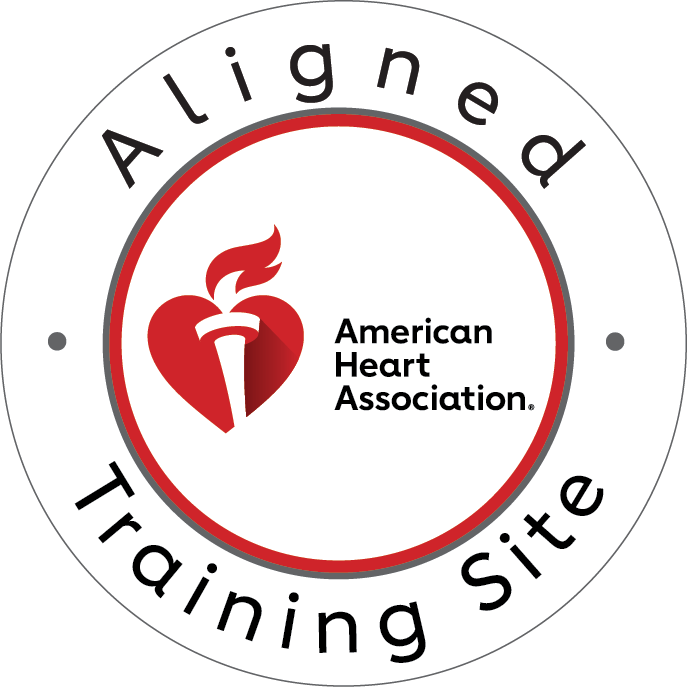The American Heart Association's BLS Healthcare Provider Course
The American Heart Association's BLS Healthcare Provider Course is an in-person training program that teaches you about how to recognize and treat sudden cardiac arrest in all age groups (SCA), foreign body airway obstruction, and other life-threatening conditions.
This training class is a requirement for many healthcare providers to meet a job requirement or certification renewal. Once you complete this course it will be valid for 2 years. If you already possess a BLS card, you will simply receive a new card with an updated expiration date on it when completing this course.

The American Heart Association BLS Certification Exam
The American Heart Association BLS Healthcare Provider Course Exam is designed to test your knowledge on the skills learned during class. You will be tested on how to recognize sudden cardiac arrest, team dynamics, and foreign body airway obstructions in patients.
The exam is not difficult, but it is important to pay attention throughout the course and ask questions if you don't understand something. There are 25 questions total; you must pass with a score of at least 84%. Your time limit for this exam is one hour, but most students complete their exam and receive their BLS certification within 20 - 30 minutes. The best way to prepare for your American Heart Association BLS Healthcare Provider Course Exam is by taking notes during class, reviewing them thoroughly before taking your exam, and asking any questions that come up during lecture or discussion with other students/instructors in order to better understand key concepts
Don't get discouraged if you don't pass the first time—you can take it the same day up to three times for free.
In order to pass the American Heart Association's BLS Healthcare Provider Course Exam, you have to correctly answer at least 84% of the questions. If for some reason you don't reach this score after three attempts, your instructor will hand you an alternate new version of the exam.
The Exam is open notes, and you may use any course materials, and or technology available at the time of the exam. While the course is meant to be interactive, taking some time to review can help calm your nerves so you can stay focused on what you need to do during the course.

By studying the information below, you will be guaranteed to ace your exam! The following list is not in any particular order, but it is the most comprehensive list of facts that you need to know to do well on your exam.
High-quality CPR should be initiated by trained healthcare providers if a patient is not responding, has no visible signs of breathing, and does not have a pulse within 5-10 seconds. In most cases, the public is encouraged to immediately initiate CPR when a person is not responding and has no signs of breathing.
Be aware of your limits as a rescuer. If you know your limitations as a rescuer, you will not hesitate to ask for help before a situation worsens. Knowing when to ask for help will prevent you from taking on a task that is beyond your capabilities.
In order to respond quickly, ensure that clear roles and responsibilities are defined as soon as possible. The Team Leader’s role is to clearly define and delegate tasks according to each team member’s skill level.
Rescuers should rotate positions after every two minutes or sooner if fatigued, to ensure high-quality chest compressions.
In adults and adolescents, chest compressions should be performed at a depth of 2 inches.
When a victim is not responding and not breathing, chest compressions are crucial to ensuring good blood flow to the heart and brain. Performing between 100 and 120 compressions per minute will maximize cardiac output, allowing for full chest recoil and compressions of appropriate depth. This action along with rapid defibrillation is likely to have the greatest impact on survival.
To relieve choking in an infant, give back slaps and chest thrusts. If the victim becomes unresponsive, Activate EMS and begin CPR with compressions. If you see an object in the throat, remove it if you can.
When the automated external defibrillator arrives, you should unpack it immediately and turn it on. As soon as you turn on the machine, it will direct you through a series of commands that must be carried out quickly.
Once the AED arrives, unpack it immediately and turn it on. As soon as you do, the machine will tell you exactly what to do.
Never use an AED while in a pool or other body of water. Instead, get out of the water and move your victim to dry land before administering first aid. Once they are on dry land, you can remove the remove the victim’s clothing and quickly dry the chest to apply the AED pads. Rescuers should also be aware that chest hair can interfere with the adhesion of AED pads. A defibrillator kit may include a razor to quickly shave the chest of the victim. If a razor is unavailable, apply firm pressure as you place the pads.
Administering an automated external defibrillator (AED) and providing appropriate defibrillation as early as possible is an important link in the chain of survival for victims of cardiac arrest, since the AED eliminates the abnormal heart rhythm.
You witness a person collapse. The person is unresponsive and making gasping sounds, but there is no pulse. You phone 9-1-1. It is important to remember that the gasps are not normal breathing and indicate that cardiac arrest has occurred. CPR should be started immediately.
You may be surprised to learn that allowing complete chest recoil is one of the most important parts of high-quality CPR. If the chest is allowed to recoil fully during high quality cardiopulmonary resuscitation, blood can refill the heart.
If you want to be sure that your bag-mask device is working correctly during CPR, make sure that you can see the person's chest rise with each breath.
The AHA BLS In-person class is a great way to get certified, but it's also a great way to learn about CPR and other healthcare issues. So do yourself a favor and not only be prepared for your certification, but also keep your life-saving knowledge fresh by recertifying at least every two years. Don't put it off any longer… take the course and get certified today at Willow Grove CPR #1 Certification Training Provider in the Philadelphia Area.


American Heart Association Certified Training Provider
2735 Terwood Rd. Unit H, Willow Grove, PA


